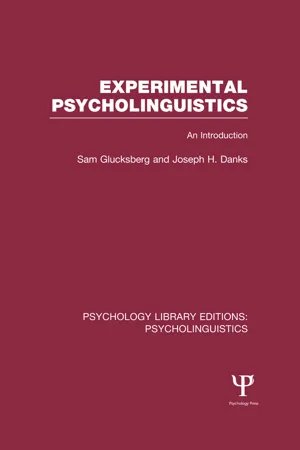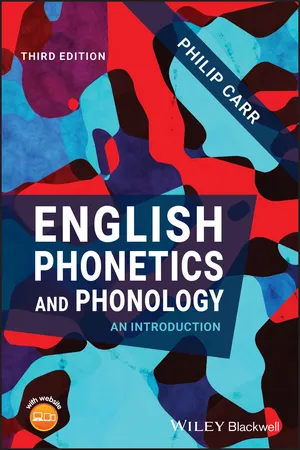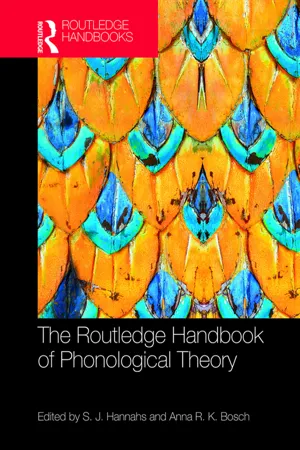Languages & Linguistics
Phoneme
A phoneme is the smallest unit of sound in a language that can distinguish one word from another. It represents a set of speech sounds that are perceived as the same by speakers of a language. For example, the "p" and "b" sounds in English are considered separate phonemes because they can change the meaning of a word, such as "pat" and "bat."
Written by Perlego with AI-assistance
Related key terms
1 of 5
11 Key excerpts on "Phoneme"
- eBook - ePub
- Bruce M. Rowe, Diane P. Levine(Authors)
- 2022(Publication Date)
- Routledge(Publisher)
In reality, in spoken language, a Phoneme is a class of sounds or phones that speakers and listeners perceive as being one sound. The Phonemes /b/ and /p/ have no meaning in themselves. Yet words that are the same except for a difference of one Phoneme (in the same position in each word) contrast. That is, they have different meanings (e.g., bit and pit). The word perceived is used earlier in this paragraph because, as mentioned previously, a Phoneme is a mental construct that tells a listener that two or more sounds function as the same sound or different sounds, regardless of the acoustic properties of the sound. For example, [p] and [p h ] are acoustically (physically) somewhat different sounds, yet native English speakers (who have not taken a linguistics class) perceive them as being the same sound. Therefore, native speakers would call them both the p sound. The word Phoneme comes from the Greek root meaning sound. Yet Phonemes are not sounds. A Phoneme is a mental construct. No one has ever heard a Phoneme. In the case of /p/, the listener hears either [p] or [p h ] or various other allophones of /p/ that we have not discussed. The unit /p/ exists in the mind of the speaker and listener. The /p/ and all other Phonemes are organizational and functional units with no physical properties of their own. Not only is a Phoneme not a sound, but it also does not have to refer to sound. Phonemes exist in soundless languages such as American Sign Language (ASL). We discuss the Phonemes of ASL in Chapter 11. Sounds such as [p] and [p h ], which are allophones of the same Phoneme /p/ in English, might be different (separate) Phonemes in another language. For example, in Hindi the aspirated [p h ] sound and the unaspirated [p] sound are different Phonemes. In Hindi, [kapi] means copy, whereas [kap h i] means ample. This difference in meaning between words that are identical except for aspiration is consistent in Hindi - eBook - ePub
Experimental Psycholinguistics (PLE: Psycholinguistics)
An Introduction
- Sam Glucksberg, Joseph H. Danks(Authors)
- 2013(Publication Date)
- Psychology Press(Publisher)
Categorization. Third, all units of speech are members of categories, and we perceive them as such. Whenever we use a word, we symbolize a category of events, things, or relationships. At the level of speech sounds a unit of sound itself, the Phoneme, is really a category of speech sounds that are functionally equivalent. Our ability to discriminate between categories is extremely good; our ability to discriminate among members within the same category is quite poor. This principle is clearly demonstrated in speech perception, and is also applicable to our perception and interpretation of larger speech units.In this chapter we refer to each of these three general principles of language behavior in the context of the sound system of English and the facts and theories of speech perception. We shall see later that these three principles apply with equal force to word, sentence, and message processing.Sounds and PhonemesEvery human language has a relatively small set of sounds that is unique to that language. Languages sound different from one another, but the differences we hear are not caused by different orderings or sequences of the same set of speech sounds. Instead, different languages use different sets of sounds, each set consisting of a relatively small number of Phonemes. A Phoneme is defined as the smallest unit in a language that makes a meaningful difference to people who speak that language. Listen to the initial sounds of the words bad and pad. The only difference between them is in their first sound. Since this difference in the initial sounds produces two different words, the difference is a meaningful one. This meaningful difference, OF contrast, defines /b/ and /p/1 as two different Phonemes. Similarly, bad and bid are two different words. Hence, the difference between /æ/ and /I / is a meaningful difference, and so /æ/ and /I / are two different Phonemes, as well. Finally, one can contrast bad and bat to discover that /d/ and /t/ are also two different Phonemes. Two speech sounds are defined as different Phonemes if, when one is substituted for the other in a word, the result is two different meaningful words.Why do we take so much trouble to define phonemic differences? Why can’t we simply say that two speech sounds are different if they sound different? The problem here is that people who speak different languages perceive the speech sounds differently. Two speech sounds that sound very different to people who speak English may not sound different to people who do not speak English. We clearly hear the difference between rice and rise and between ice and eyes - eBook - ePub
How to Study Linguistics
A Guide to Understanding Language
- Geoffrey Finch, Martin Coyle, John Peck(Authors)
- 2017(Publication Date)
- Bloomsbury Academic(Publisher)
It exists as a physical entity which can be changed every day, and it exists for me as a mental reality which is unchanging. And similarly with sounds. Phonetics is concerned with the physical substance of sound, that is, with phones. But there’s also an abstract level to sounds, a level on which they are mental, semantic realities. It’s this level which our new alphabet has to capture. On this level we need a new term to describe the initial sound of cool and cat which we are saying is the same and of which the two phones we identified above are variants. We can call this sound a Phoneme. The best definition of this unit is Jean Aitchison’s in Teach Yourself Linguistics : ‘A Phoneme is the smallest segment of sound which can distinguish two words’ (1992, p. 39). We have established an important principle of our new alphabet then which is that the symbols will only represent contrastive speech sounds. Phones are only important to us in so far as they also represent Phonemes. The difference between the two phones at the beginning of cat and cool is phonetic but not phonemic. If we use the symbol /k/ to represent the Phoneme we can say that it is realised, that is, represented, in sound by two phones, [k h +] and [k h –]. The plus symbol indicates that the phone is towards the front of the mouth and the minus symbol indicates its towards the back, whilst the little ‘h’ tells us that both phones are aspirated (try the test mentioned earlier in connection with p). But again, another term would be useful here to express the relationship between phones and Phonemes: it would enable us to short-circuit descriptions like ‘realised’, or ‘represented’ in sound. We can say that these phones are allophones, that is, variants, of the Phoneme /k/ - eBook - ePub
Language and the Lexicon
An Introduction
- David Singleton(Author)
- 2016(Publication Date)
- Routledge(Publisher)
Let us begin with that aspect of the interaction between the lexicon and phonology which is labelled above as ‘self-evident’. Given that knowledge of a lexical expression typically includes knowledge of how that expression is pronounced, we have to assume that an entry in the lexicon contains information about the sounds out of which the item in question is composed – just as entries in dictionaries may contain ‘phonetic’ transcriptions. The sound components of a lexical unit include: (i) the relevant sequence of individual sound segments, (ii) (in languages such as English) the pattern of stress-distribution in the unit in question, and (iii) (in languages such as Chinese and Thai) the specific pitch or tone characteristic of the expression concerned when used in a particular sense.With regard to individual sound segments, we saw in Chapter 1 that some differences between sounds were critical in differentiating between words and that some were not. We noted that distinctions that are critical in this way are labelled phonemic, and that the sound units which are, as it were, kept apart by such distinctions are called Phonemes. Phonemes can thus be looked upon as collections of distinctive features - eBook - ePub
Understanding English Language Teaching in EFL Context
From Idea to Practicality
- Kamal Ud Din(Author)
- 2023(Publication Date)
- Routledge India(Publisher)
top-down approach, in contrast to the bottom-up approach mentioned earlier. In this approach, a whole word or sentence is pronounced as a whole first and trained listeners to be able to reproduce the same. Once learners have enough practice in saying the whole word or sentence, then gradually, they are taught individual sounds for more clarity and recognition of individual sounds in the word or the sentence(s) under study. This approach works best for some learners as they seem to be better at catching the whole sentence if they are meaningful ones. Besides, the functionalist approach recommends that language teaching should primarily focus on meaning-making, which results also in the learning of language forms. Functionalists consider this approach more effective for language learning as it enhances the communicative ability of the learners.6.4 Phonology: Concepts and Teaching Approaches
Phonology is a compound word, consists of the Greek root words of phone and logos. Phone means voice, especially distant voice as used in a telephone, and logos means reason. In the EFL context, while discussing phonology, a question that is commonly asked is the difference in terms, such as the difference between phone and sound. Phone is the sound when we make when we speak, while ‘sound’ is a general term used to indicate any sound in the environment like the sound of trumpets. The phones which are perceived in the mind are called Phonemes, and phonology is, thus, the study of Phonemes. Phonemes are individual sounds that are well identified and can be represented in a written form also. A written symbol that is used to represent the distinguished individual sound/Phoneme is called a grapheme. In other words, graphene means the written symbol of a Phoneme. A Phoneme basically is a distinct and recognized sound in spoken form and thus is used in a particular language; for example, the English language has 45 Phonemes. Similarly, other languages have also their own distinctive set of sounds/Phonemes.When it comes to the teaching of English, especially as a foreign language, the formal education system starts with the teaching of the English 26-lettered Alphabet system. English language learners are hardly aware of the Phonemes, and thus, they fail to distinguish between letters and Phonemes. The area of spelling, as a result, becomes one of the toughest areas for EFL learners. They do not recognize why the same letter ‘U’ sounds different in the words, such as in ‘university’ and in ‘umbrella’. Here comes the need for teaching Phonemes to clarify such confusion. To help EFL teachers and learners, a list of such common sounds had been given in a tabular form at the end of this chapter. The tables contain all the Phonemes and different example words containing the sounds/Phonemes used in the English language. It is hoped that after going through them, the confusion will be clarified that arises from the lack of understanding between the letter and sound-spelling relationship. The letters may represent more than one Phoneme as was the case in the example of ‘university’ and umbrella.’ Therefore, Phonemes are thus more in number than letters. There are many concepts used to make teachers aware of the important aspects that can be taught at this level, for example, activities designed to raise phonological awareness and phonemic awareness among young learners. - eBook - PDF
Linguistic Fundamentals for Natural Language Processing
100 Essentials from Morphology and Syntax
- Emily M. Bender(Author)
- 2022(Publication Date)
- Springer(Publisher)
CHAPTER 2 Morphology: Introduction #7 Morphemes are the smallest meaningful units of language, usually consisting of a sequence of phones paired with concrete meaning. Morphology is the subfield oflinguistics concerned with the formation and internal structure of words. It encompasses morphotactics, or questions of which morphemes are allowed to combine within a word and in what order; morphophonology, how the form of morphemes is conditioned by other morphemes they combine with; and morphosyntax, how the morphemes in a word affect its combinatoric potential. 1 In all three cases, the units under consideration are morphemes, which can be defined as the smallest meaningful units oflanguage. A morpheme is typically a sequence of phones (sounds) paired with a concrete meaning. 2 A simple example is given in (6) where the boundaries between morphemes (with words) are indicated by'+': (6) Morpheme+s are the small+est mean+ing+ful unit+s oflanguage. This example, however, belies the actual complexity of morphological systems. As described be- low, both the 'form' and the 'meaning' part of the pairing can vary from the prototypes in impor- tant ways. Specifically, the form can be made up of phones which are not contiguous (#8), it can be made up of something other than phones (#9), it can in fact be null (#10), and finally the form can vary with the linguistic context (#23-#26). On the meaning side, in addition to core lexical meaning (#11), morphemes can convey changes to that meaning (#12) (which furthermore can be idiosyncratic (#13)) and/or syntactically or semantically relevant features (#14, #28-#43) #8 The phones making up a morpheme don't have to be contiguous. While prototypical morphemes are sequences of phones (sounds, represented by letters in alphabetic writing systems) which furthermore have easily identified boundaries between them, there are several ways in which morphemes can depart from this prototypical case. - eBook - ePub
English Phonetics and Phonology
An Introduction
- Philip Carr(Author)
- 2019(Publication Date)
- Wiley-Blackwell(Publisher)
5 The Phonemic Principle5.1 Introduction: Linguistic Knowledge
We have been dealing, thus far, with phonetics, that is (as we have defined it), with the study of human speech sounds (although we have dealt exclusively with English phonetics, and in particular, exclusively articulatory phonetics, ignoring important facts about the acoustic properties of the speech sounds we have been discussing). We will, henceforth, be dealing with phonology, as well as phonetics. Phonology, we will claim, is to do with something more than properties of human speech sounds per se. Phonology is the study of certain sorts of mental organization. In particular, it is the study of certain types of mental category, mentally stored representations, and generalizations concerning those categories and representations. On this view, phonology is not the study of human speech sounds per se, although phonetics and phonology are inextricably intertwined. The point of this chapter is to demonstrate what the difference between the two is, and to begin to introduce the reader to the phonology of English. Let us begin by considering some general questions concerning what it is to know a language.Let us assume that when we say that someone knows a language, in the sense of being a native speaker of that language, he or she is in a certain mental state, or possesses a certain sort of linguistic knowledge. Knowledge of a native language is, apparently, largely unconscious knowledge. It appears to contain semantic knowledge (to do with the meanings of words, phrases and sentences) and syntactic knowledge (to do with the syntactic categories of words, with the structure of phrases and sentences and with the syntactic relations between words, phrases and clauses). We know that this is so, since speakers are able to make syntactic and semantic judgements, based on that knowledge. For instance, a native speaker of English can judge that Who did you see Graham with? is an English sentence, and that Who did you see Graham and? is not. The speaker knows, again intuitively, that the difference between the two amounts to more than the difference between the mere presence of the word and as opposed to the presence of the word with. He or she also knows intuitively (not necessarily fully consciously) in what sense He told the man who he knew is ambiguous, and in what sense the two interpretations of that sequence of words differs in structure and meaning from He told the man how he knew, over and above the superficial fact that one sequence contains who and the other how. That knowledge is clearly unconscious knowledge, since we require no instruction to be able to make such judgements, and we can make them in the absence of any conscious knowledge whatsoever of the syntax and semantics of English (one could make such judgements even if one had not the faintest idea of what a noun or a verb might be, or what the syntactic categories of with, and, who and how - eBook - ePub
Speech to Print
Language Essentials for Teachers
- Louisa Cook Moats(Author)
- 2020(Publication Date)
- Brookes Publishing(Publisher)
Figure 3.4 .The reading brain. (Based on Dehaene, 2009.)The speech codes, or phonological representations, that are used for language operations are abstract mental codes for the features of the sounds in words. When we know a word, we know its sequence of speech sounds and its stress patterns (accents) well enough to say it and recognize it as a unique entity. Phonological codes must be detailed to allow us to distinguish similar-sounding words, such as entomology and etymology, reverent and relevant, and play dough and Plato. Phonological mental codes may be wrongly specified, incomplete, or unstable in students who have phonological processing weaknesses. These codes may be insufficient to support accurate word pronunciation and/or the sound–symbol matching process necessary to read and write.Phonological processing is an integral part of oral language because words by definition have sound, meaning, and roles in sentences. In one sense, words are names; names are phonological codes that are linked to a meaningful referent. Let’s examine in more detail what is involved in each aspect of phonological processing.Speech Perception and ProductionSpeech perception and production are among the unconscious activities carried out by the phonological processing system. Speech perception, also one aspect of receptive language, includes the abilities to distinguish between words that sound almost alike (e.g., dusk/dust; fill/fail; shark/shock) and recognize familiar words as they are spoken. Speech is perceived by the brain as a set of acoustic signals or sound frequencies formed by the vocal actions of a speaker. Phoneme discrimination or speech discrimination are terms used for the ability to distinguish words that differ only in one Phoneme. The term auditory discrimination - eBook - ePub
- Phil Rose(Author)
- 2002(Publication Date)
- CRC Press(Publisher)
7 Phonemics
Speech sounds in individual languages
The preceding chapter introduced the general speech-sound producing capabilities of humans. It was intended to give a brief answer to the question: what is the articulatory nature of the speech sounds that humans use?However, forensic phonetics does not look at speech sounds context-free, as in the previous chapter, but as they occur in the speech of someone speaking a particular language. There is a profound difference between these two ways of looking at speech sounds. It is a fact of the structure of Language that speech sounds operate on two different levels, and because of this dual structure it is not enough, indeed it is not possible, to describe the similarities and differences between two or more samples of speech in terms of the articulatory (or perceptual) nature of the sounds alone: to say, for example, that sample A has such and such an inventory of sounds compared with sample B.The two different levels at which speech sounds exist are called the phonetic level and the phonemic level, and the difference between them is often called the etic-emic difference. The former, phonetic level, has been covered in Chapter 6: it describes speech sounds tout court, without reference to a particular language. The latter, phonemics, can be seen as a conceptual framework within which to describe the sounds of a given language, or dialect. It is thus language-specific, although its analytical principles are supposed to be applicable to all languages. This chapter introduces those principles. It describes how forensic phoneticians, and indeed most descriptive linguists (linguists who have to do with the description of languages), conceptualise the structure of the sound component of Language. It also describes how speakers can differ in phonemic structure.Most introductory textbooks on linguistics or phonetics, for example Fromkin et al. (1999: 247–69), Crowley et al. (1995: 48–114), Finegan et al. - eBook - ePub
- S.J. Hannahs, Anna Bosch, S.J. Hannahs, Anna Bosch(Authors)
- 2017(Publication Date)
- Routledge(Publisher)
The functionalist/formalist distinction has a particular resonance in phonology, given the position of phonology within the architecture of the language system: phonology is often said to lie at the interface between (mental) grammar and (physical) externalization. While phonetics is typically concerned with physical aspects of the study of speech (externalization), phonology encompasses the connections between the sound system and the grammar of language. In recent years, this distinction has been blurred in various ways, particularly across the domain of phonological theory: usage-based analyses as in the work of Bybee (e.g. 2003, 2010) appeal to facts about speech and language use, such as frequency of a lexical item, to account for observations about language; corpus-based work (Durand, Gut & Kristoffersen 2014) interprets observations about language from the facts of speech; Articulatory Phonology (Browman & Goldstein 1986) suggests that the organization of phono-logical systems can be attributed to the muscular movements or gestures inherent in the articulation of speech. Even more formal approaches to phonology, such as OT, appeal to the role of phonetic detail, for instance in the arguments for phonetic grounding of optimality constraints (Hayes, Kirchner & Steriade 2004).These various approaches in recent years have served to blur the distinction between phonetics and phonology, to the extent that some scholars assume that phonology is non-distinct from phonetics (Johnson 2007), while others take the further step that phonology is merely part of the externalization of language and is therefore not part of the grammar at all (Burton-Roberts 2011). Moreover, those scholars who accept that there is a distinction between phonetics and phonology nonetheless draw the demarcation between the two fields of study at different points, e.g. Hale & Reiss (2008), Blaho (2008), and Iosad (2012) arguing that phonology is abstract and thus independent of phonetics (i.e. ‘substance-free’), while others such as Hayes, Kirchner & Steriade (2004) and Archangeli & Pulleyblank (1994) argue that phonology is phonetically grounded. - Victoria Fromkin, Robert Rodman, Nina Hyams, , Victoria Fromkin, Robert Rodman, Nina Hyams(Authors)
- 2018(Publication Date)
- Cengage Learning EMEA(Publisher)
Editorial review has deemed that any suppressed content does not materially affect the overall learning experience. Cengage Learning reserves the right to remove additional content at any time if subsequent rights restrictions require it. Exercises 255 Linguists may use a mathematical-like formulation to express phonological rules in a concise way. For example, the rule that nasalizes vowels when they occur before a nasal consonant within the same syllable may be written as: V → [ 1nasal] / [ 1nasal]$ Morphophonemic rules apply to specific morphemes such as the past tense morpheme /d/, which is phonetically [d], [t], or [ǝd] depending on the final Phoneme of the verb to which it is attached. The phonology of a language also includes sequential constraints (phonotactics) that determine which sounds may be adjacent within the syl- lable. These determine what words are possible in a language, and what pho- netic strings are impermissible. Possible but nonoccurring words constitute accidental gaps and are nonsense words, for example, blick [blɪk]. Phonologi- cal rules exist in part to enforce phonotactic constraints. To discover the Phonemes of a language, linguists (or students of linguistics) can use a methodology such as looking for minimal pairs of words, or for sounds that are in complementary distribution. The phonological rules in a language show that the phonemic shape of words is not identical with their phonetic form. The Phonemes are not the actual pho- netic sounds, but are abstract mental constructs that are realized as sounds by the operation of rules such as those described in this chapter. No one is taught these rules, yet everyone knows them subconsciously. Exercises Data in languages other than English are given in phonetic transcription without square brackets unless otherwise stated. The phonetic transcriptions of English words are given within square brackets.
Index pages curate the most relevant extracts from our library of academic textbooks. They’ve been created using an in-house natural language model (NLM), each adding context and meaning to key research topics.










